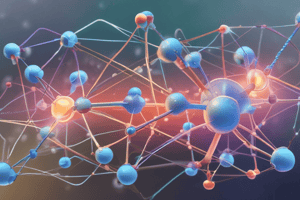Podcast
Questions and Answers
What was the plum pudding model of the atom?
What was the plum pudding model of the atom?
Atom is a ball of positive charge with negative electrons embedded in it.
Describe the findings of the alpha particle scattering experiment.
Describe the findings of the alpha particle scattering experiment.
The experiment concluded that the mass of an atom was concentrated at the centre (nucleus) and that the nucleus was charged.
What is the smallest part of an element that can exist?
What is the smallest part of an element that can exist?
Atom
According to Neil Bohr, how do electrons behave in an atom?
According to Neil Bohr, how do electrons behave in an atom?
How are compounds different from mixtures?
How are compounds different from mixtures?
What did James Chadwick's work contribute to the atomic model?
What did James Chadwick's work contribute to the atomic model?
What process can be used to separate mixtures that involve physical processes, not chemical reactions?
What process can be used to separate mixtures that involve physical processes, not chemical reactions?
How can compounds be separated into elements?
How can compounds be separated into elements?
What is the difference between compounds and mixtures?
What is the difference between compounds and mixtures?
Explain the concept of chemical symbols in relation to atoms.
Explain the concept of chemical symbols in relation to atoms.
How can compounds be separated into elements?
How can compounds be separated into elements?
In what way do mixtures differ from compounds in terms of separation methods?
In what way do mixtures differ from compounds in terms of separation methods?
What does a compound contain and how is it represented?
What does a compound contain and how is it represented?
What was the key conclusion drawn from the alpha particle scattering experiment?
What was the key conclusion drawn from the alpha particle scattering experiment?
How did Neil Bohr contribute to the model of the atom?
How did Neil Bohr contribute to the model of the atom?
What did later experiments reveal about the positive charge in a nucleus?
What did later experiments reveal about the positive charge in a nucleus?
How did James Chadwick's work contribute to the atomic model?
How did James Chadwick's work contribute to the atomic model?
What is the significance of the atomic number of an element?
What is the significance of the atomic number of an element?




